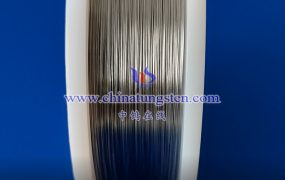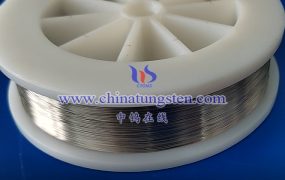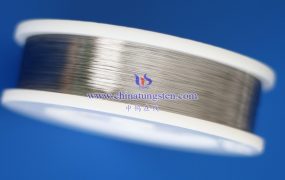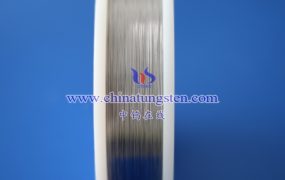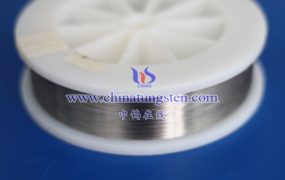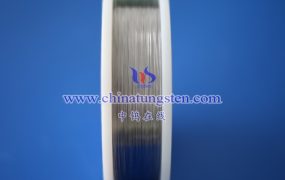Tungsten wire made by powder metallurgy and plastic processing methods. Tungsten wire is divided into pure tungsten wire and non-sagging tungsten wire. Pure tungsten wire is made of tungsten powder with a purity of 99.95%; most of the tungsten wire is non-sagging tungsten wire. Non-sagging tungsten wire is a tungsten wire made by adding 0.025%~0.05%Al2O3, 0.3%~0.45%SiO2, 0.25%~0.45%K2O to the tungsten oxide raw material, also known as doped tungsten wire or anti-sag Tungsten. Non-sagging tungsten wire is named because it does not deform (sag) like pure tungsten wire when used above the recrystallization temperature. Pure tungsten wire is mainly used as electron tube grid wire, side rod, lead wire, bracket, electrode of gas discharge lamp, heating element, etc. Non-sagging tungsten wires are mainly used as incandescent lamp filaments, electron tube heating wires, cathodes, grid wires, gas discharge lamp electrodes, poles, lead wires, etc.
A brief history In 1879, Edison invented the electric light, using carbon filaments. In 1906, tungsten wire made by slurry extrusion method appeared. In 1909, American W.D. Coolidge used tungsten powder pressing-forming-sintering-swiveling-drawing technology to lay the foundation for the production of tungsten wire, making lighting lamps enter thousands of households. In 1918, when the Hungarian Pac’z used oxide refractory crucible to roast WO3 in the United States, he accidentally discovered that the tungsten wire produced with this raw material had good anti-sagging properties after recrystallization. After 218 repeated tests and researches, it was found that a small amount of refractory oxide mixed in the crucible worked, thus laying the foundation for the production of non-sagging tungsten wire. In the United States, the non-sagging tungsten wire is still called 218 tungsten wire. In 1917, American merchants founded Qiqi Company in Shanghai, China, and imported tungsten wire instead. After 1938, Guilin Electron Tube Factory also switched to importing tungsten wire. In September 1953, under the leadership of Zheng Liangyong, Shanghai Light Bulb Factory established a complete set of equipment from powder making to wire drawing, and produced the first tungsten wire made in China. In 1956, Beijing Electronic Tube Factory was equipped with a complete set of tungsten wire production equipment and technology, engaged in the production of tungsten wire, molybdenum wire, tungsten-molybdenum alloy wire, and thorium tungsten wire. In the 1960s, two more alloy factories were established one after another to produce tungsten-molybdenum wire, and tungsten-rhenium alloy wire was developed and put into industrial production. Since the 1970s, more than a dozen professional factories have been established one after another. The annual production capacity of tungsten wire reaches 5 billion m.
Doping Mechanism Tungsten wire is mostly used as bulb filament, and its service temperature is as high as 2000~3000℃. Bulb filaments, electron tube heating wires, and cathodes all use non-sagging tungsten wires instead of pure tungsten wires.
(1) The recrystallization temperature of pure tungsten wire is lower than 1500°C. Moreover, it is as brittle as glass at room temperature after recrystallization, and is severely deformed at high temperatures. This is because: after recrystallization, it forms an equiaxed crystal structure (Fig. 1), the grain boundaries are straight, and the grain boundaries along the direction perpendicular to the silk axis are easily brittle when bent at room temperature. Grains slip along grain boundaries at high temperatures leading to sag deformation.
(2) The secondary recrystallization temperature of non-sagging tungsten wire is as high as 1900-2500°C, and crystals that grow longitudinally along the wire axis are formed during recrystallization (Figure 2). And it often forms jagged interlocking grain boundaries, which prevents the slippage of grains at high temperatures, and has a good ability to resist sagging deformation. Since the grain boundary perpendicular to the filament axis is greatly reduced, the probability of brittle fracture along the grain boundary at room temperature is also greatly reduced, so it has a certain bending plasticity. This effect is attributed to the role of dopants – Al2O3, SiO2, K2O. The study believes that the main reason is that trace potassium enters the microstructure of tungsten, and after high temperature sintering, tiny potassium bubbles are formed in tungsten. During processing and heat treatment, potassium bubbles are alternately elongated and split into finer bubble columns (Figure 3). These bubble columns, which are as small as a few microns or even a few tenths of a micron in diameter, are arranged along the silk axis to act as nails. When the tungsten wire is recrystallized, the grain growth cannot exceed the limit of the potassium bubble column, so that the grain grows along the wire axis. The role of Al2O3 is to promote the effective potassium content, and SiO2 is considered to mainly play a role in regulating the particle size of tungsten powder.
Preparation method Use powder metallurgy method to make tungsten billet, then forge and wire drawing.
Preparation of tungsten powder Usually, ammonium paratungstate extracted from tungsten concentrate is used as raw material, which is roasted in air at 500-600°C to produce WO3, or lightly reduced and decomposed into blue tungsten oxide in hydrogen. After doping, it is reduced into tungsten powder twice with hydrogen in a tube furnace. The first reduction temperature is 600-700°C and the product is WO2. The second reduction temperature is 800-900°C, and the product is tungsten powder. Its Fischer particle size is usually about 3 μm, and the oxygen content is about 0.1%. Potassium content (60 ~ 120) × 10-6 is appropriate. Tungsten powder sometimes needs to be washed with hydrofluoric acid to remove excess dopant for sintering and processing. The adjustment of powder particle size can be realized by methods such as reduction temperature, speed, hydrogen flow rate and loading capacity.
Billet production Put tungsten powder into a steel die, and use a mechanical press to press it into a rectangular bar with a cross-sectional size of 12.5mm×12.5mm, a length of 400mm, and a weight of 650g or a size of 15mm×15mm×600mm. 1.5kg billet. Heavier and larger billets can be formed by isostatic pressing. The billet is pre-sintered in a hydrogen furnace at 1200°C for about 0.5h in advance to make it have a certain process strength and electrical conductivity; then, it is sintered by direct electric heating, and the sintering temperature reaches about 3000°C, making it possible Wrought metal tungsten bar. The density of doped tungsten strips is preferably 17-17.8g/cm3, and the density of pure tungsten strips can reach about 18g/cm3.
Plastic processing mainly includes rotary die forging and drawing.
Rotary die forging is a commonly used method for blanking tungsten rods. Three large, medium and small rotary forging machines process the billet to about φ3mm, and the compression rate of each pass is usually 10% to 25%. Billets are heated at a temperature of 1300-1600°C, and primary or secondary recrystallization annealing is performed between φ5.6-9.5mm. Below φ5.6mm, using several rotary forging machines to forge in series can improve production efficiency. For billets weighing several kilograms, rolling billet technology is necessary and the most advanced.
Drawing is divided into thick wire drawing and thin wire drawing. (1) Thick wire (φ3.0mm~φ0.26mm) drawing. Gas and electric heating are used, and the silk processing temperature is 700-1200°C. Carbide wire drawing die is used, graphite milk is used as lubricant, and the compression rate of each pass is 13% to 28%. The small billet can be reduced to about φ1.25mm with a chain wire drawing machine, and then drawn with a winding wire drawing machine. Large billets can be drawn by crawler and large turntable wire drawing machines. The selection of processing temperature, mold quality, graphite milk quality, annealing point and annealing temperature all have an impact on the quality of the wire. (2) Filament drawing. It is drawn by a temperature-stabilized electric heating furnace and a diamond die. The pass compression rate is 8% to 20%, and the drawing temperature is 500 to 800°C. The use of multi-mode wire drawing machine can improve production efficiency and reduce equipment footprint. The thinnest mechanical wire drawing can reach φ10μm, and the ultra-fine wire must be completed by electrolytic corrosion. In addition to the drawing temperature, the pass type of the mold (opening angle, compression pressure, length of the sizing belt), surface finish and the quality of the graphite milk (particle size, shape, adhesion, density, etc.) all have an important impact on the drawing quality. The common “shrinkage” phenomenon is often caused by poor quality of mold and graphite milk. In order to eliminate processing stress, restore plasticity and improve deformation conditions, it is necessary to formulate a reasonable intermediate annealing point and annealing system according to the finished product specifications. Semi-finished silk and finished silk need to be inspected for high temperature performance, plasticity, strength, flatness, winding performance and surface quality to determine the grade and actual quality.
